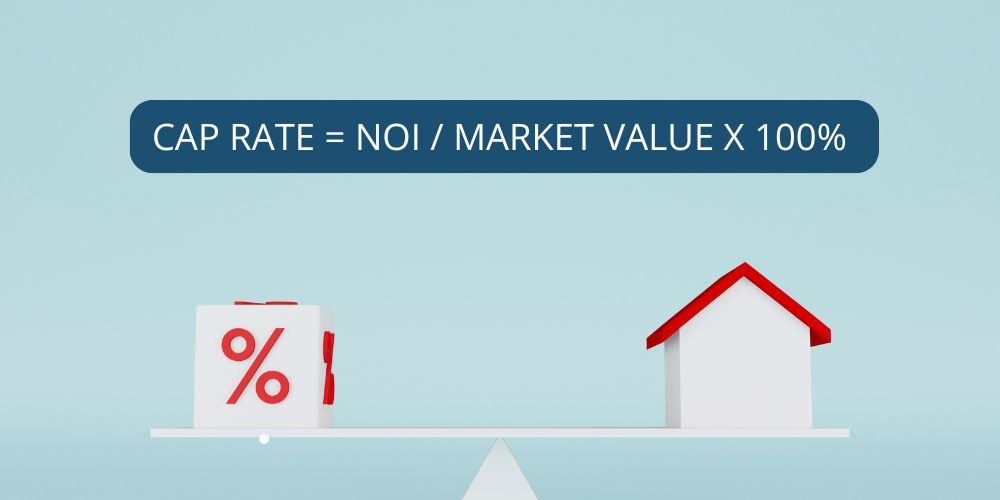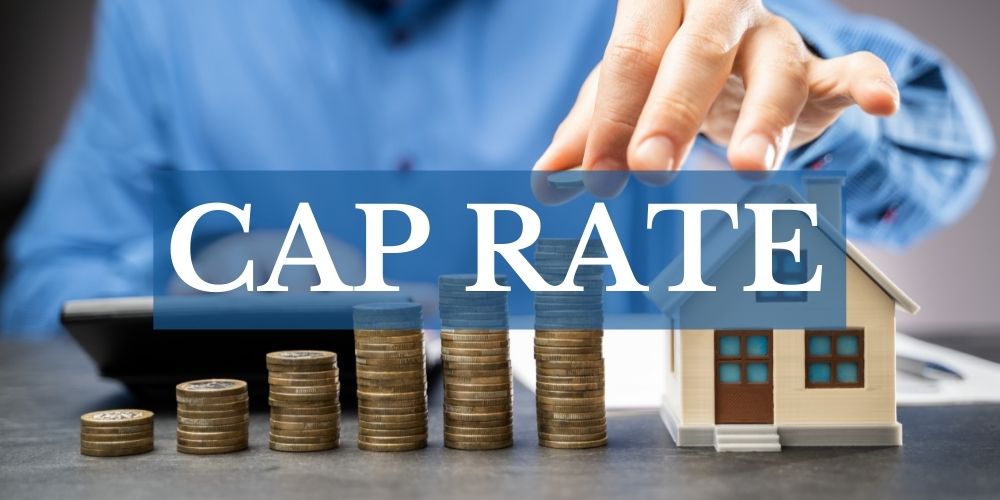The cap rate is a critical metric for real estate investors, offering a snapshot of a property’s potential return based on its income relative to its price. It aids in comparing investment opportunities quickly and screening for properties that align with investment goals. However, it has limitations, such as overlooking factors like property appreciation, financing costs, and market fluctuations. Effective use involves considering additional factors like property condition, local rental market trends, and long-term investment strategy to make well-informed investment decisions.
Cap Rate Definition
What is a cap rate? Cap rate is a very important term and calculation in commercial real estate. Cap Rate, or capitalization rate, is the ratio of Net Operating Income (NOI) to the property asset value. For example, if a property sold for $2,000,000 and had an NOI of $100,000, then the cap rate would be $100,000/$1,000,000, or 5%. In the Current Market, cap rates are in the 2 to 4 % range in the Toronto Commercial Real Estate Market.
Cap Rate Formula:
Cap Rate = NOI / Market Value x 100%
- Net Operating Income (NOI): This represents the property’s annual income after subtracting all reasonable and recurring expenses associated with operating the property. These expenses typically include:
- Property taxes
- Insurance
- Maintenance costs
- Property management fees (if applicable)
- Vacancy rates (accounting for potential rental income lost due to unoccupied units)

How to Calculate Cap Rate for Canada:
- Gather Information: You’ll need the property’s annual gross rental income, operating expenses, and current market value.
- Calculate Net Operating Income (NOI): Subtract the operating expenses from the annual gross rental income. (Gross Rental Income – Operating Expenses = NOI)
- Calculate Cap Rate: Divide the NOI by the property’s market value and multiply by 100% to express the result as a percentage. (NOI / Market Value x 100% = Cap Rate)
Example:
- Let’s say a property in Canada generates a gross rental income of $100,000 annually.
- The annual operating expenses for the property amount to $20,000.
- The current market value of the property is $1,000,000.
Net Operating Income (NOI): $100,000 (gross income) – $20,000 (expenses) = $80,000
Cap Rate: ($80,000 NOI / $1,000,000 market value) x 100% = 8%
Interpreting Cap Rate:
In this example, the 8% cap rate suggests that the property is expected to generate an 8% annual return on investment based solely on the rental income. It’s important to note that cap rates are a starting point for evaluation and should be considered alongside other factors like market trends, property type, and location.
What is a Reasonable Good Cap Rate?
Determining a “good” cap rate in real estate investment varies based on investor preferences and market conditions. It reflects the relationship between a property’s income and its price, with higher cap rates indicating potentially higher returns relative to cost. Lower cap rates signify lower risk but may require more time to recover initial investments. Investors set cap rate thresholds based on their risk tolerance and financial goals, enabling efficient evaluation of properties that align with their investment strategies.
Best way of using the Cap Rate Ratio
The cap rate is a ratio used extensively in the commercial real estate industry and it can be beneficial in several ways to making a decision. The cap rate is used for a quick assessment during the due diligence period or simply to compare to other properties or the current benchmark cap rate. The cap rate can be used to assess if an interested acquisition is worth considering for a future purchase. A 4% cap rate acquisition versus a 6% cap rate acquisition for a similar property in a similar location can quickly tell you that one property has a higher risk premium.
Another way the calculation of cap rates can be helpful is when they form a trend. If you’re looking at cap rate trends over the past few years in a particular sub-market, then the trend can indicate where that market is headed. For instance, if cap rates are compressing that means values are being bid up and a market is heating up. Where are values likely to go next year? Looking at historical cap rate data can quickly give you insight into the direction of valuations.
While cap rates are useful for quick back-of-the-envelope calculations, it is important to note when cap rates should not be used. When properly applied to a stabilized Net Operating Income (NOI) projection, the simple cap rate can produce a valuation approximately equal to what could be generated using a more complex discounted cash flow (DCF) analysis. However, if the property’s net operating income stream is complex and irregular, with substantial variations in cash flow, only a fully discounted cash flow analysis will yield a credible and reliable valuation.
Components of the Cap Rate
What are the components of the cap rate and how can they be determined? One way to think about the cap rate is that it’s a function of the risk-free rate of return plus some risk premium. In finance, the risk-free rate is the theoretical rate of return of an investment with no risk of financial loss. Of course, in practice, all investments carry even a small amount of risk. However, because U.S. bonds are considered to be very safe, the interest rate on a U.S. Treasury bond is normally used as the risk-free rate. How can we use this concept to determine cap rates?
Suppose you have $10,000,000 to invest and 10-year treasury bonds are yielding 3% annually. This means you could invest all $10,000,000 into treasuries, considered a very safe investment, and spend your days at the beach collecting checks. What if you were presented with an opportunity to sell your treasuries and instead invest in a Class A office building with multiple tenants? A quick way to evaluate this potential investment property relative to your safe treasury investment is to compare the cap rate to the yield on treasury bonds.
Suppose the acquisition cap rate on the investment property was 5%. This means that the risk premium over the risk-free rate is 2%. This 2% risk premium reflects all of the additional risk you assume over and above the risk-free treasuries, which takes into account factors such as:
- Age of the property.
- The covenant or credit ranking of the tenants.
- The diversity of the tenants.
- Length of tenant leases in place.
- Broader supply and demand fundamentals in the market for this particular asset class.
- Underlying economic fundamentals of the region including population growth, employment growth, and inventory of comparable space on the market.
When you take all of these items and break them out, it’s easy to see their relationship with the risk-free rate and the overall cap rate. It’s important to note that the actual percentages of each risk factor of a cap rate and ultimately the cap rate itself are subjective and depend on your own business judgment and experience.
Is cashing in your treasuries and investing in an office building at a 5% acquisition cap rate a good decision? This, of course, depends on how risk-averse you are. An extra 2% yield on your investment may or may not be worth the additional risk inherent in the property. Perhaps you are able to secure favorable financing terms and using this leverage you could increase your return from 5% to 8%. If you are a more aggressive investor this might be appealing to you. On the other hand, you might want the safety and security that treasuries provide, and a 3% yield is adequate compensation in exchange for this downside protection.
Band of Investment Method
The above risk-free rate approach is not the only way to think about cap rates. Another popular alternative approach to calculating the cap rate is to use the band of investment method. This approach takes into account the return to both the lender and the equity investors in a deal. The band of investment formula is simply a weighted average of the return on debt and the required return on equity. For example, suppose we can secure a loan at an 80% Loan-to-value (LTV), amortized over 20 years at 6%. This results in a mortgage constant of 0.0859. Further, suppose that the required return on equity is 15%. This would result in a weighted average cap rate calculation of 9.87%.
(80%*8.59% + 20%*15%= 9.87%)
In conclusion, understanding cap rates is essential for informed real estate investment decisions, allowing investors to weigh potential risks and rewards effectively. Allen Mayer emphasizes the importance of applying these concepts with careful consideration of market dynamics and individual investment strategies.

